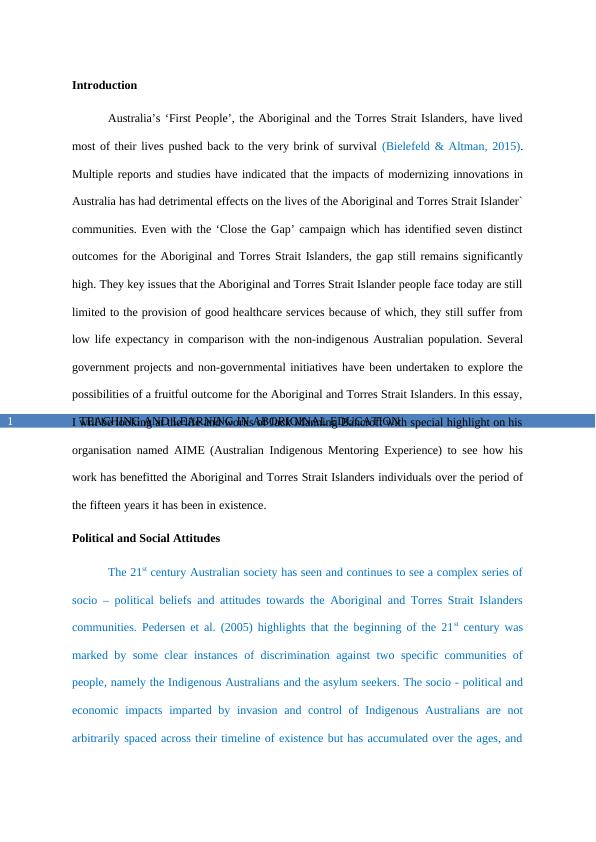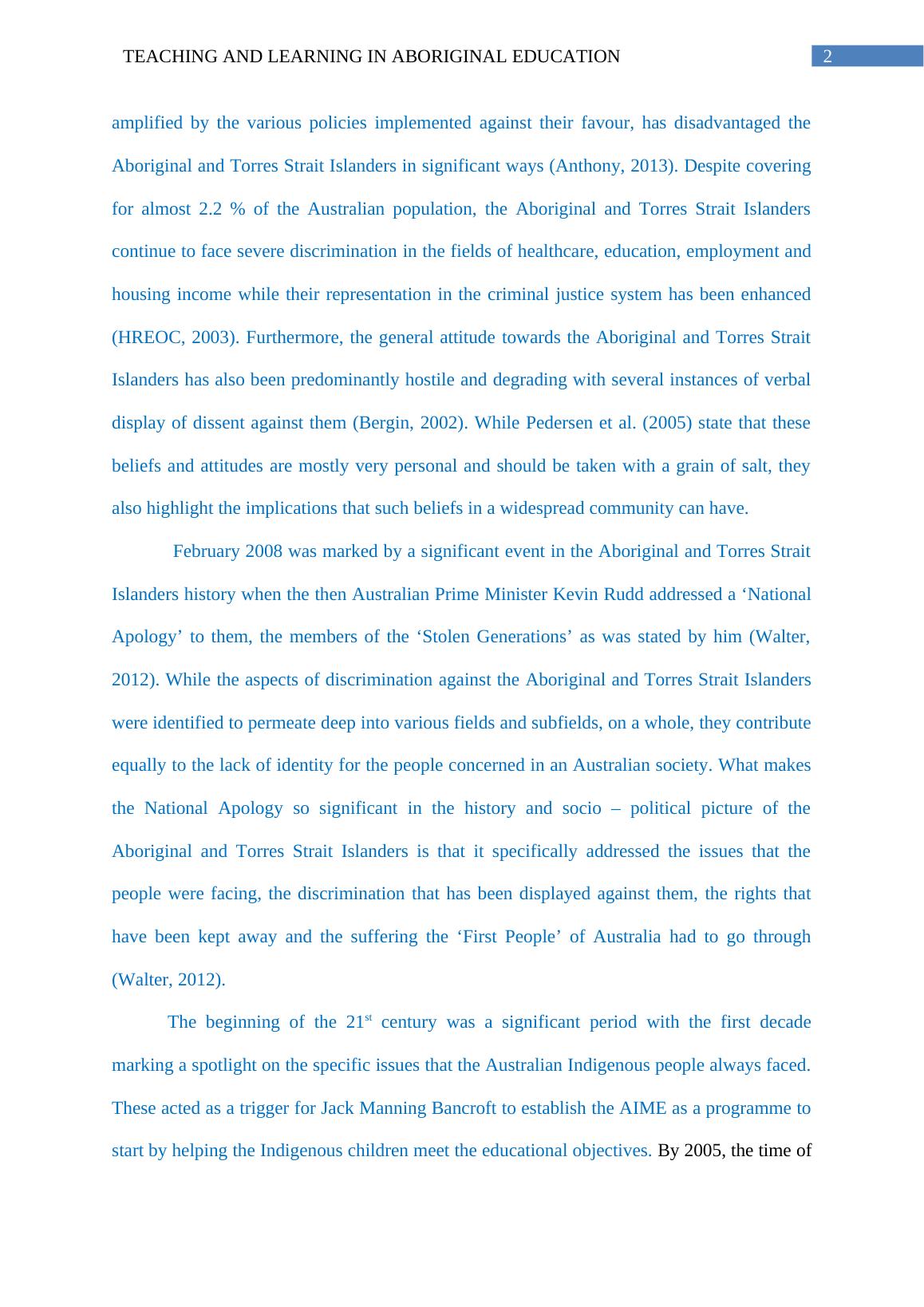Teaching and Learning in Aboriginal Education Report 2022
Added on 2022-09-17
9 Pages2573 Words18 Views
Running head: TEACHING AND LEARNING IN ABORIGINAL EDUCATION
TEACHING AND LEARNING IN ABORIGINAL EDUCATION
Name of the Student
Name of the University
Author note
TEACHING AND LEARNING IN ABORIGINAL EDUCATION
Name of the Student
Name of the University
Author note

TEACHING AND LEARNING IN ABORIGINAL EDUCATION1
Introduction
Australia’s ‘First People’, the Aboriginal and the Torres Strait Islanders, have lived
most of their lives pushed back to the very brink of survival (Bielefeld & Altman, 2015).
Multiple reports and studies have indicated that the impacts of modernizing innovations in
Australia has had detrimental effects on the lives of the Aboriginal and Torres Strait Islander`
communities. Even with the ‘Close the Gap’ campaign which has identified seven distinct
outcomes for the Aboriginal and Torres Strait Islanders, the gap still remains significantly
high. They key issues that the Aboriginal and Torres Strait Islander people face today are still
limited to the provision of good healthcare services because of which, they still suffer from
low life expectancy in comparison with the non-indigenous Australian population. Several
government projects and non-governmental initiatives have been undertaken to explore the
possibilities of a fruitful outcome for the Aboriginal and Torres Strait Islanders. In this essay,
I will be looking at the life and works of Jack Manning Bancroft with special highlight on his
organisation named AIME (Australian Indigenous Mentoring Experience) to see how his
work has benefitted the Aboriginal and Torres Strait Islanders individuals over the period of
the fifteen years it has been in existence.
Political and Social Attitudes
The 21st century Australian society has seen and continues to see a complex series of
socio – political beliefs and attitudes towards the Aboriginal and Torres Strait Islanders
communities. Pedersen et al. (2005) highlights that the beginning of the 21st century was
marked by some clear instances of discrimination against two specific communities of
people, namely the Indigenous Australians and the asylum seekers. The socio - political and
economic impacts imparted by invasion and control of Indigenous Australians are not
arbitrarily spaced across their timeline of existence but has accumulated over the ages, and
Introduction
Australia’s ‘First People’, the Aboriginal and the Torres Strait Islanders, have lived
most of their lives pushed back to the very brink of survival (Bielefeld & Altman, 2015).
Multiple reports and studies have indicated that the impacts of modernizing innovations in
Australia has had detrimental effects on the lives of the Aboriginal and Torres Strait Islander`
communities. Even with the ‘Close the Gap’ campaign which has identified seven distinct
outcomes for the Aboriginal and Torres Strait Islanders, the gap still remains significantly
high. They key issues that the Aboriginal and Torres Strait Islander people face today are still
limited to the provision of good healthcare services because of which, they still suffer from
low life expectancy in comparison with the non-indigenous Australian population. Several
government projects and non-governmental initiatives have been undertaken to explore the
possibilities of a fruitful outcome for the Aboriginal and Torres Strait Islanders. In this essay,
I will be looking at the life and works of Jack Manning Bancroft with special highlight on his
organisation named AIME (Australian Indigenous Mentoring Experience) to see how his
work has benefitted the Aboriginal and Torres Strait Islanders individuals over the period of
the fifteen years it has been in existence.
Political and Social Attitudes
The 21st century Australian society has seen and continues to see a complex series of
socio – political beliefs and attitudes towards the Aboriginal and Torres Strait Islanders
communities. Pedersen et al. (2005) highlights that the beginning of the 21st century was
marked by some clear instances of discrimination against two specific communities of
people, namely the Indigenous Australians and the asylum seekers. The socio - political and
economic impacts imparted by invasion and control of Indigenous Australians are not
arbitrarily spaced across their timeline of existence but has accumulated over the ages, and

TEACHING AND LEARNING IN ABORIGINAL EDUCATION2
amplified by the various policies implemented against their favour, has disadvantaged the
Aboriginal and Torres Strait Islanders in significant ways (Anthony, 2013). Despite covering
for almost 2.2 % of the Australian population, the Aboriginal and Torres Strait Islanders
continue to face severe discrimination in the fields of healthcare, education, employment and
housing income while their representation in the criminal justice system has been enhanced
(HREOC, 2003). Furthermore, the general attitude towards the Aboriginal and Torres Strait
Islanders has also been predominantly hostile and degrading with several instances of verbal
display of dissent against them (Bergin, 2002). While Pedersen et al. (2005) state that these
beliefs and attitudes are mostly very personal and should be taken with a grain of salt, they
also highlight the implications that such beliefs in a widespread community can have.
February 2008 was marked by a significant event in the Aboriginal and Torres Strait
Islanders history when the then Australian Prime Minister Kevin Rudd addressed a ‘National
Apology’ to them, the members of the ‘Stolen Generations’ as was stated by him (Walter,
2012). While the aspects of discrimination against the Aboriginal and Torres Strait Islanders
were identified to permeate deep into various fields and subfields, on a whole, they contribute
equally to the lack of identity for the people concerned in an Australian society. What makes
the National Apology so significant in the history and socio – political picture of the
Aboriginal and Torres Strait Islanders is that it specifically addressed the issues that the
people were facing, the discrimination that has been displayed against them, the rights that
have been kept away and the suffering the ‘First People’ of Australia had to go through
(Walter, 2012).
The beginning of the 21st century was a significant period with the first decade
marking a spotlight on the specific issues that the Australian Indigenous people always faced.
These acted as a trigger for Jack Manning Bancroft to establish the AIME as a programme to
start by helping the Indigenous children meet the educational objectives. By 2005, the time of
amplified by the various policies implemented against their favour, has disadvantaged the
Aboriginal and Torres Strait Islanders in significant ways (Anthony, 2013). Despite covering
for almost 2.2 % of the Australian population, the Aboriginal and Torres Strait Islanders
continue to face severe discrimination in the fields of healthcare, education, employment and
housing income while their representation in the criminal justice system has been enhanced
(HREOC, 2003). Furthermore, the general attitude towards the Aboriginal and Torres Strait
Islanders has also been predominantly hostile and degrading with several instances of verbal
display of dissent against them (Bergin, 2002). While Pedersen et al. (2005) state that these
beliefs and attitudes are mostly very personal and should be taken with a grain of salt, they
also highlight the implications that such beliefs in a widespread community can have.
February 2008 was marked by a significant event in the Aboriginal and Torres Strait
Islanders history when the then Australian Prime Minister Kevin Rudd addressed a ‘National
Apology’ to them, the members of the ‘Stolen Generations’ as was stated by him (Walter,
2012). While the aspects of discrimination against the Aboriginal and Torres Strait Islanders
were identified to permeate deep into various fields and subfields, on a whole, they contribute
equally to the lack of identity for the people concerned in an Australian society. What makes
the National Apology so significant in the history and socio – political picture of the
Aboriginal and Torres Strait Islanders is that it specifically addressed the issues that the
people were facing, the discrimination that has been displayed against them, the rights that
have been kept away and the suffering the ‘First People’ of Australia had to go through
(Walter, 2012).
The beginning of the 21st century was a significant period with the first decade
marking a spotlight on the specific issues that the Australian Indigenous people always faced.
These acted as a trigger for Jack Manning Bancroft to establish the AIME as a programme to
start by helping the Indigenous children meet the educational objectives. By 2005, the time of

End of preview
Want to access all the pages? Upload your documents or become a member.
Related Documents
Closing the Gap Policy and its Significance to Indigenous Australianslg...
|9
|2301
|364
Engaging Effectively with Culturally Diverse Peoplelg...
|13
|3972
|67
Indigenous Education and Perspectives Quiz Questions 2022lg...
|4
|508
|21
Aboriginal and Torres Strait Islander Culture on Educationlg...
|9
|2886
|231
Aboriginal & Torres Strait Islander Health Assignmentlg...
|8
|2250
|107
Contemporary Indigenous Health And Wellbeing Report 2022lg...
|8
|2234
|15
